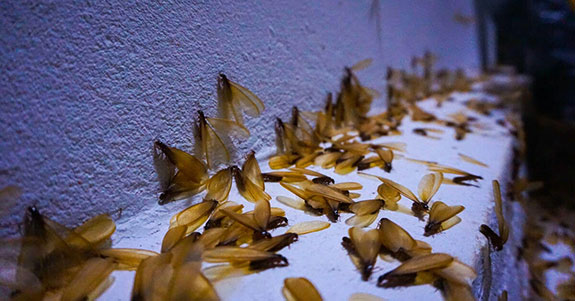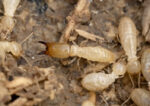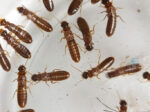
What to Know about Termite Swarming Season
As the warmer and rainy months approach, South Floridians must be aware that termite swarming season is also upon us, putting homes and businesses at increased risk of becoming infested. In fact, South Florida is home to many of the cities known for having some of the most termite infestations nationwide. During “swarm season”, it is especially important to be on the lookout for signs of termite colonies around your property during this time of year, as infestations that go undetected can lead to the need for serious and costly repairs. In general, when it comes to termite swarm season, termite species in Florida tend to see a sharp increase of swarms as we head out of the cooler and dryer winter months and into the hot and humid climate that the region is famously known for. Learn all about termite season in Florida, what to be on the lookout for, and when to call Hulett Environmental Services here.
One of the best ways to get ahead of termite swarming season in Florida is to schedule for frequent inspection and a preventative treatment before you notice a problem with the pests. Call Hulett Environmental Services today to schedule a FREE inspection of your home or business. Our pest control professionals will provide you with a comprehensive analysis of your property’s termite treatment needs, including individualized pricing. Don’t wait for termite season in Florida to get the best of your home. Make sure you’re a step ahead of the pesky creatures, and JUST CALL HULETT today.
So What Is a Termite Swarm?
A termite swarm occurs when a large group of the pests, often up to several hundreds or even thousands at a time, fly about in a localized area looking for the next place to build their colony. Generally, the termites will fly toward a source of light, which can make the interior of your home particularly appealing.
A termite swarm generally lasts anywhere from 30 to 40 minutes. You will likely notice the pests around windows, porch lights, glass doors, and more. They can make their way into your home via open doors, the garage, cracks in windows or doors, soffits, or any other space that allows for entry.
These “swarmers,” or flying termites, will not bite or sting your family members or pets. However, they are attempting to establish new colonies, and if successful, the new colony will indeed cause structural damage to your home. With help from a professional, early detection and treatment can make quickly eliminating these termites much more feasible. There are many different species of termites that can be found in South Florida, and each have a specific and unique period of time that the species can be observed to take part in these reproductive flights. This duration of weeks or months that a termite species will leave the nest in attempt to fly and find a mate and reproduce is referred to as the “swarm season”.
If you do notice a termite swarm in Florida, either inside or outside of your home, don’t wait until you find damage to wood in attics, crawl spaces, facia, flooring, door and window frames, and more. Instead, contact Hulett Environmental Services right away. One of our professionals will arrive at your site promptly to evaluate any possible colony formation and administer the appropriate treatment as soon as possible.
When Is Termite Swarming Season in Florida?
There are several species of termites in Florida, each with its own swarming tendencies. As South Florida is warm and humid nearly year-round, various species of termites swarm during different months. The exact environmental stimuli that triggers a termite to swarm is still somewhat unknown, but in general, some termite species swarm with higher levels of humidity or temperature compared to others, while some types of termites swarm during the day, and others night. However, there are a few things that all termite swarms have in common. For example, all termite swarmers will have four wings, straight antenna, and a broad waist. But in terms of color and size, there are subtle differences between the species that often take a professional to differentiate by looking at minute differences in wing venation. For a list of common termite species in Florida, as well as the months and conditions they can be found swarming, see the list below. However, keep in mind, these characteristics are very subtle and it is best to consult with a professional and trained inspector.
Termite swarm season in Florida, by species:
- Eastern Subterranean Termite: This termite is also sometimes referred to as one of Florida’s native subterranean termites. This termite typically swarms from November through May, with greatest intensity between January and April. This small and dark-colored termite generally swarms during daylight hours and is known to shed its veined and “net-like” wings near windows.
- Dark Southeastern Subterranean Termite: This termite is also part of the native subterranean termite group, as it is also native to Florida. This species of termite is also dark-colored and swarms during warm and sunny days. However, their swarm season is typically from Mid-October through June, with greatest intensity from March through May.
- Light Southeastern Subterranean Termite: This termite is considered to be more rare and less of a threat to structures in South Florida than the other subterranean termites, but it can still infest from time to time. This species is the last of the native subterranean termite group, and typically swarms from November to March with greatest intensity between December and February. A qualified inspector is important for this termite, because this native subterranean termite is light in color and swarms in the evening, unlike the other native subterranean termites. Because of this, it has a history of being misidentified as a Drywood Termite.
- Formosan Subterranean Termite: This termite is an invasive and exotic subterranean termite to South Florida, but it has since become established and has quickly spread throughout the South Florida coastlines. This large, hairy, and yellow termite can be found swarming from March through July and is likely the most concerning termite to homeowners in terms of its potential to cause damage.
- Asian Subterranean Termite: This termite can be considered the tropical counterpart of and is closely related to the Formosan Subterranean Termite. The Asian Subterranean Termite looks very similar in terms of its size and the noticeable hair on the wings and body. One difference is that the “back” of this termite is a darker orange-brown color, but its “belly” still shows the characteristic yellowish color as seen with the Formosan termite. This termite swarm season is typically greatest from March to May, but it can be found swarming as early as February.
- West-Indian Powderpost Drywood Termite: This is likely the most common Drywood termite that infests South Florida homes. This small and caramel-colored termite has distinct iridescent wings and typically swarms at night towards exterior lighting. This drywood termite can be found swarming primarily from March to August in large swarms, but has been known to have several smaller swarms throughout the entire year.
- Southeastern Drywood Termite: Perhaps not as common, but this termite is also a concern for homeowners for potential drywood termite damage in South Florida. This termite has a larger swarmer body that is a pale yellow color, and can be found swarming from April through September.
With so many termite species swarming into the Spring and Summer, it is essential that you take steps to protect your home or business now. Once you notice termites swarming inside your house, it is likely that an infestation is either already present or will occur. Don’t wait until you notice substantial damage to call a professional for assistance. Contact Hulett Environmental Services today for a FREE inspection and to develop a preventative treatment plan. But, there are also some helpful tips and tricks that homeowners can complete to lessen there chance of being infested by swarming termites.
What Attracts Swarming Termites?
Swarming termites gravitate toward sources of light, which can make any home an appealing target. However, there are additional factors that can increase the termite appeal of your property, too. As we move into the warmer months and the termite swarm season in Florida picks up, it is important to be highly cognizant of these things around your home to help minimize the chance of potential infestation.
During termite swarming season in Florida, addressing the following factors can help lessen the appeal of your home to the pests:
- Exterior Lighting. During swarm season, it is a good idea to limit your sources of exterior lighting during the evenings. This can help lessen the attractiveness of your home to nearby swarming termites.
Piles of wood or other wood to ground contact. Whether you have lumber leftover from a home improvement project, piles of sticks from a yard cleanup, or any other source of wood, make sure to clean it up as quickly as possible. Termites prefer to build colonies near sources of wood. - Piles of leaves, dead plants, or obstructions from inspecting the foundation of your home. Clear your yard of any debris, such as dead leaves, piles of grass clippings, and more. Make sure to sweep out garages, clear front patios and doorways of any plant debris, so you can clearly see the foundation of your home for early subterranean termite detection.
- Fix moisture issues. If your home has any lingering moisture issues from a leaking door, window, roof, or plumbing, this can be a conducive condition for subterranean termites and it is best to fix the water intrusion.
- Call Hulett. A trained inspector will discuss with you and your family the best options for a customized Termite Prevention Program for your property.
Preparing for Termite Swarm Season in Florida
When it comes to termite swarming season in Florida, knowledge is your best defense. Be aware of what to look for, what you can do to make your home less appealing to the pests, and know to call for help at the first sign of a termite swarm. At Hulett Environmental Services, we’ve been helping homeowners in South Florida for more than 50 years with termite prevention and treatment services. We’re experts when it comes to the unique pest problems faced by residents throughout the region.
Call Hulett Environmental Services today to learn more about the termite prevention and infestation treatment options available to South Florida homeowners. Our inspectors are trained by a Board Certified Entomologist, and are able to complete a thorough inspection of your property and discuss with you the various ways you can lessen your chance of infestation, including preventative treatment. Start preparing for termite swarming season today and protect your largest asset. JUST CALL HULETT!



